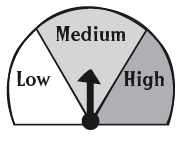Action Plan 7.11 Playing to Lose
 NASPE Standards
NASPE Standards
2, 3
Objective
Students learn to balance caloric intake while participating in a speed and agility activity.
Concepts and Skills
To maintain a healthy weight, we must know how many calories we consume and how many we burn. Certain activities burn more calories than others do. In this action plan, students demonstrate the following skills:
- Fitness (general)
- Agility
- Movement
- Social and self-awareness
- Other (an understanding of nutrition and body composition)
Introduction
When athletes stop playing and training in sports and physical activities, they start to lose their muscle mass and often gain weight. An athlete named Matt seems to have traded his six-pack abs for a spare tire.
Tips
Revisit how the number of calories in and calories out determines whether we gain or lose weight. Use 3,500 for the caloric value of a pound of body weight. Discuss the food groups, vitamins, nutrients, and water, and explain that we need a balance of these to be healthy. Revisit the concept that when the balance is out of whack, our bodies show it. Now, introduce how exercise helps to keep our muscles in shape, which not only helps our bodies have better shape but also helps us burn off calories.
Rubric
3 = Participated in the Burn and Balance activity; comprehended the idea of caloric burn from the Burn and Balance game and the calories burned ranking table; completed the worksheet
2 = Two of the three criteria listed for 3
1 = One of the three criteria listed for 3
Equipment
Hula hoops, polyspots with caloric values
Directions
1. Paraphrase the following story:
Matt, a football player, likes to show off his six-pack abs. His abdomen usually has ripples of hard muscles. But lately, the ripples seem to be disappearing, or moving to the sides of his waist. Ever since football season ended, Matt sits on the couch and eats potato chips and watches TV for hours and hours. The ripple relocation is because he has replaced exercise with sitting and eating.
We don’t want Matt to go from Musclemattic Matt to Fat Matt. Let’s help Matt balance his 2,000 calories a day with exercise. After you balance the calories in the Burn and Balance game, rank the activities from most calories burned to least calories burned. This way, we can give Matt choices for action instead of just letting him watch TV and eat bags of chips.
2. Have students work on the class challenge worksheet.
3. In the center of the room, place polyspots with caloric values taped underneath them, as follows:
- 20 polyspots marked 90 calories
- 20 polyspots marked 200 calories
- 20 polyspots marked 300 calories
- 20 polyspots marked 500 calories
- 8 polyspots marked Milkshake! (700 calories)
4. Place different-colored polyspots with calorie-burning activities taped underneath them, as follows:
- 5 polyspots marked Walking (50 calories)
- 5 polyspots marked Running (300 calories)
- 5 polyspots marked Swimming (300 calories)
- 5 polyspots marked Throwing (30 calories)
- 5 polyspots marked Climbing stairs (400 calories)
- 5 polyspots marked Riding bike (200 calories)
5. Arrange students in pairs behind hula hoops that form the perimeter of a circle.
6. Students take turns with their partners running to pick up a spot and returning with it.
7. The object is to stick to a 2,000-calorie diet, so at the end of the game each pair wants their spots to total 2,000.
8. Instead of taking a new spot from the center, a team can choose to give an unwanted spot to another team.
- Students should give away spots that make it hard for them to total 2,000 calories.
- Students can’t give a spot to the two teams immediately to their left or right.
9. Have students play for a minute or two while you check to see if anyone has 2,000 calories; then have them stop.
- Use the teachable moment to discuss eating habits and exercising.
- Use real food examples and activities in a discussion of how calories add up to 2,000 and how they can be burned.
- Explain what happens when people take in excessive calories or too few calories.
- Ask students how the exercises differ in terms of calories burned and why.
10. Review the 14 ranked activities on the class challenge worksheet.
11. Reset the polyspots and have students play the game again.

Enrichment
- Show pictures of people in action and discuss how different exercises burn calories.
- Have one student perform arm circles for 20 seconds and another perform jumping jacks for 20 seconds. When they finish, discuss the difference in the number of calories burned for each activity.
- Instead of taping caloric values to the polyspots, use cards that display caloric and nutritional values.
Wrap-Up
How hard was it to keep your calories at 2,000? It’s a little easier when you move and exercise to burn some of those calories. Balancing calories can be hard in real life, especially when there are changes in your life. There will be temptations that will make your daily count too high, and then you will put on weight because you took in too many calories. So, when you do overeat, make sure to work out a little more than usual to burn off the extra calories. At home, ask your parents how they balance their calories. Do they work out?
Take-Home Challenge
Students ask their parents how they balance their caloric intake and then practice balancing snacks and desserts with exercise.
